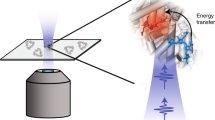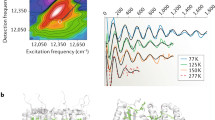Abstract
In oxygenic photosynthesis, light harvesting is regulated to safely dissipate excess energy and prevent the formation of harmful photoproducts. Regulation is known to be necessary for fitness, but the molecular mechanisms are not understood. One challenge has been that ensemble experiments average over active and dissipative behaviours, preventing identification of distinct states. Here, we use single-molecule spectroscopy to uncover the photoprotective states and dynamics of the light-harvesting complex stress-related 1 (LHCSR1) protein, which is responsible for dissipation in green algae and moss. We discover the existence of two dissipative states. We find that one of these states is activated by pH and the other by carotenoid composition, and that distinct protein dynamics regulate these states. Together, these two states enable the organism to respond to two types of intermittency in solar intensity—step changes (clouds and shadows) and ramp changes (sunrise), respectively. Our findings reveal key control mechanisms underlying photoprotective dissipation, with implications for increasing biomass yields and developing robust solar energy devices.
This is a preview of subscription content, access via your institution
Access options
Access Nature and 54 other Nature Portfolio journals
Get Nature+, our best-value online-access subscription
$29.99 / 30 days
cancel any time
Subscribe to this journal
Receive 12 print issues and online access
$259.00 per year
only $21.58 per issue
Buy this article
- Purchase on Springer Link
- Instant access to full article PDF
Prices may be subject to local taxes which are calculated during checkout




Similar content being viewed by others
References
Amerongen, H. & Croce, R. Light harvesting in photosystem II. Photosynth. Res. 116, 251–263 (2013).
Ruban, A. V., Johnson, M. P. & Duffy, C. D. The photoprotective molecular switch in the photosystem II antenna. Biochim. Biophys. Acta 1817, 167–181 (2012).
Rochaix, J.-D. Regulation and dynamics of the light-harvesting system. Annu. Rev. Plant Biol. 65, 287–309 (2014).
Erickson, E., Wakao, S. & Niyogi, K. K. Light stress and photoprotection in Chlamydomonas reinhardtii. Plant J. 82, 449–465 (2015).
Berteotti, S., Ballottari, M. & Bassi, R. Increased biomass productivity in green algae by tuning non-photochemical quenching. Sci. Rep. 6, 21339 (2016).
Kromdijk, J. et al. Improving photosynthesis and crop productivity by accelerating recovery from photoprotection. Science 354, 857–861 (2016).
Peers, G. et al. An ancient light-harvesting protein is critical for the regulation of algal photosynthesis. Nature 462, 518–521 (2009).
Bonente, G. et al. Analysis of lhcsr3, a protein essential for feedback de-excitation in the green alga Chlamydomonas reinhardtii. PLoS Biol. 9, e1000577 (2010).
Alboresi, A., Gerotto, C., Giacometti, G. M., Bassi, R. & Morosinotto, T. Physcomitrella patens mutants affected on heat dissipation clarify the evolution of photoprotection mechanisms upon land colonization. Proc. Natl Acad. Sci. USA 107, 11128–11133 (2010).
Tokutsu, R. & Minagawa, J. Energy-dissipative supercomplex of photosystem II associated with LHCSR3 in Chlamydomonas reinhardtii. Proc. Natl Acad. Sci. USA 110, 10016–10021 (2013).
Pinnola, A. et al. Zeaxanthin binds to light-harvesting complex stress-related protein to enhance nonphotochemical quenching in Physcomitrella patens. Plant Cell 25, 3519–3534 (2013).
Pinnola, A. et al. Heterologous expression of moss light-harvesting complex stress-related 1 (LHCSR1), the chlorophyll a-xanthophyll pigment–protein complex catalyzing non-photochemical quenching, in Nicotiana sp. J. Biol. Chem. 290, 24340–24354 (2015).
Pinnola, A. et al. Light-harvesting complex stress-related proteins catalyze excess energy dissipation in both photosystems of Physcomitrella patens. Plant Cell 27, 3213–3227 (2015).
Maruyama, S., Tokutsu, R. & Minagawa, J. Transcriptional regulation of the stress-responsive light harvesting complex genes in Chlamydomonas reinhardtii. Plant Cell Physiol. 55, 1304–1310 (2014).
Liguori, N., Novoderezhkin, V., Roy, L. M., van Grondelle, R. & Croce, R. Excitation dynamics and structural implication of the stress-related complex LHCSR3 from the green alga Chlamydomonas reinhardtii. Biochim. Biophys. Acta 1857, 1514–1523 (2016).
Liguori, N., Roy, L. M., Opacic, M., Durand, G. & Croce, R. Regulation of light harvesting in the green alga Chlamydomonas reinhardtii: the C-terminus of LHCSR is the knob of a dimmer switch. J. Am. Chem. Soc. 135, 18339–18342 (2013).
Ballottari, M. et al. Identification of pH-sensing sites in the light harvesting complex stress-related 3 protein essential for triggering non-photochemical quenching in Chlamydomonas reinhardtii. J. Biol. Chem. 291, 7334–7346 (2016).
Dinc, E. et al. LHCSR1 induces a fast and reversible pH-dependent fluorescence quenching in LHCII in Chlamydomonas reinhardtii cells. Proc. Natl Acad. Sci. USA 113, 7673–7678 (2016).
Ruban, A. V. et al. Identification of a mechanism of photoprotective energy dissipation in higher plants. Nature 450, 575–578 (2007).
Staleva, H. et al. Mechanism of photoprotection in the cyanobacterial ancestor of plant antenna proteins. Nat. Chem. Biol. 11, 287–291 (2015).
Bode, S. et al. On the regulation of photosynthesis by excitonic interactions between carotenoids and chlorophylls. Proc. Natl Acad. Sci. USA 106, 12311–12316 (2009).
Holt, N. E. et al. Carotenoid cation formation and the regulation of photosynthetic light harvesting. Science 307, 433–436 (2005).
Ahn, T. K. et al. Architecture of a charge-transfer state regulating light harvesting in a plant antenna protein. Science 320, 794–797 (2008).
Wahadoszamen, M., Berera, R., Ara, A. M., Romero, E. & van Grondelle, R. Identification of two emitting sites in the dissipative state of the major light harvesting antenna. Phys. Chem. Chem. Phys. 14, 759–766 (2012).
Pinnola, A. et al. Electron transfer between carotenoid and chlorophyll contributes to quenching in the LHCSR1 protein from Physcomitrella patens. Biochim. Biophys. Acta 1857, 1870–1878 (2016).
Krüger, T. P. et al. Controlled disorder in plant lightharvesting complex II explains its photoprotective role. Biophys. J. 102, 2669–2676 (2012).
Krüger, T. P. et al. The specificity of controlled protein disorder in the photoprotection of plants. Biophys. J. 105, 1018–1026 (2013).
Krüger, T. P., Ilioaia, C., Johnson, M. P., Ruban, A. V. & van Grondelle, R. Disentangling the low-energy states of the major light-harvesting complex of plants and their role in photoprotection. Biochim. Biophys. Acta 1837, 1027–1038 (2014).
Schlau-Cohen, G. S. et al. Single-molecule identification of quenched and unquenched states of lhcii. J. Phys. Chem. Lett. 6, 860–867 (2015).
Natali, A. et al. Light-harvesting complexes (LHCS) cluster spontaneously in membrane environment leading to shortening of their excited state lifetimes. J. Biol. Chem. 291, 16730–16739 (2016).
Novoderezhkin, V. I., Palacios, M. A., Van Amerongen, H. & Van Grondelle, R. Excitation dynamics in the LHCII complex of higher plants: modeling based on the 2.72 Å crystal structure. J. Phys. Chem. B 109, 10493–10504 (2005).
Schlau-Cohen, G. S. et al. Pathways of energy flow in LHCII from two-dimensional electronic spectroscopy. J. Phys. Chem. B 113, 15352–15363 (2009).
Wentworth, M., Ruban, A. V. & Horton, P. Thermodynamic investigation into the mechanism of the chlorophyll fluorescence quenching in isolated photosystem II lightharvesting complexes. J. Biol. Chem. 278, 21845–21850 (2003).
Zaks, J., Amarnath, K., Kramer, D. M., Niyogi, K. K. & Fleming, G. R. A kinetic model of rapidly reversible nonphotochemical quenching. Proc. Natl Acad. Sci. USA 109, 15757–15762 (2012).
Zaks, J., Amarnath, K., Sylak-Glassman, E. J. & Fleming, G. R. Models and measurements of energy-dependent quenching. Photosynth. Res. 116, 389–409 (2013).
Arnoux, P., Morosinotto, T., Saga, G., Bassi, R. & Pignol, D. A structural basis for the pH-dependent xanthophylls cycle in Arabidopsis thaliana. Plant Cell 21, 2036–2044 (2009).
Cardona, T., Sedoud, A., Cox, N. & Rutherford, A. W. Charge separation in photosystem II: a comparative and evolutionary overview. Biochim. Biophys. Acta 1817, 26–43 (2012).
de Wijn, R. & van Gorkom, H. J. Kinetics of electron transfer from QA to QB in photosystem II. Biochemistry 40, 11912–11922 (2001).
Hald, S., Nandha, B., Gallois, P. & Johnson, G. N. Feedback regulation of photosynthetic electron transport by NADP(H) redox poise. Biochim. Biophys. Acta 1777, 433–440 (2008).
Chmeliov, J. et al. The nature of self-regulation in photosynthetic light-harvesting antenna. Nat. Plants 2, 16045 (2016).
Van Oort, B., van Hoek, A., Ruban, A. V. & van Amerongen, H. Equilibrium between quenched and nonquenched conformations of the major plant light-harvesting complex studied with high-pressure time-resolved fluorescence. J. Phys. Chem. B 111, 7631–7637 (2007).
Chan, T. et al. Quality control of photosystem II: lipid peroxidation accelerates photoinhibition under excessive illumination. PLoS ONE 7, e52100 (2012).
Kalaji, H. M. et al. Chlorophyll a fluorescence as a tool to monitor physiological status of plants under abiotic stress conditions. Acta Physiol. Plant. 38, 102 (2016).
Alboresi, A., Caffarri, S., Nogue, F., Bassi, R. & Morosinotto, T. In silico and biochemical analysis of Physcomitrella patens photosynthetic antenna: identification of subunits which evolved upon land adaptation. PLoS ONE 3, e2033 (2008).
Niyogi, K. K. & Truong, T. B. Evolution of flexible nonphotochemical quenching mechanisms that regulate light harvesting in oxygenic photosynthesis. Curr. Opin. Plant Biol. 16, 307–314 (2013).
Morosinotto, T. & Bassi, R. in Non-Photochemical Quenching and Energy Dissipation in Plants, Algae and Cyanobacteria 315–331 (Springer, 2014).
Remelli, R., Varotto, C., Sandonà, D., Croce, R. & Bassi, R. Chlorophyll binding to monomeric light-harvesting complex; a mutation analysis of chromophore-binding residues. J. Biol. Chem. 274, 33510–33521 (1999).
Croce, R., Weiss, S. & Bassi, R. Carotenoid-binding sites of the major light-harvesting complex II of higher plants. J. Biol. Chem. 274, 29613–29623 (1999).
Aitken, C. E., Marshall, R. A. & Puglisi, J. D. An oxygen scavenging system for improvement of dye stability in single-molecule fluorescence experiments. Biophys. J. 94, 1826–1835 (2008).
Swoboda, M. et al. Enzymatic oxygen scavenging for photostability without pH drop in single-molecule experiments. ACS Nano 6, 6364–6369 (2012).
Acknowledgements
This work was supported as part of the Center for Excitonics, an Energy Frontier Research Center funded by the US Department of Energy, Office of Science, Office of Basic Energy Sciences under award no. DE-SC0001088 (MIT) and a CIFAR Azrieli Global Scholar Award to G.S.S.-C., and the EEC projects ACCLIPHOT (PITN-GA-2012-316427) and SE2B (675006-SE2B) to R.B.
Author information
Authors and Affiliations
Contributions
T.K., R.B. and G.S.S.-C. conceived and designed the experiments. T.K. and W.J.C. performed the experiments. T.K. and G.S.S.-C. analysed the data. A.P., L.D. and R.B. contributed materials and analysis tools. T.K. and G.S.S.-C. co-wrote the paper. All authors discussed the results and commented on the manuscript.
Corresponding author
Ethics declarations
Competing interests
The authors declare no competing financial interests.
Supplementary information
Supplementary information
Supplementary information (PDF 13267 kb)
Rights and permissions
About this article
Cite this article
Kondo, T., Pinnola, A., Chen, W. et al. Single-molecule spectroscopy of LHCSR1 protein dynamics identifies two distinct states responsible for multi-timescale photosynthetic photoprotection. Nature Chem 9, 772–778 (2017). https://doi.org/10.1038/nchem.2818
Received:
Accepted:
Published:
Issue Date:
DOI: https://doi.org/10.1038/nchem.2818
This article is cited by
-
Energetic robustness to large scale structural fluctuations in a photosynthetic supercomplex
Nature Communications (2023)
-
Structure of the stress-related LHCSR1 complex determined by an integrated computational strategy
Communications Biology (2022)
-
Ligand-induced transmembrane conformational coupling in monomeric EGFR
Nature Communications (2022)
-
Acclimation of Chlamydomonas reinhardtii to extremely strong light
Photosynthesis Research (2021)
-
Observation of dissipative chlorophyll-to-carotenoid energy transfer in light-harvesting complex II in membrane nanodiscs
Nature Communications (2020)



